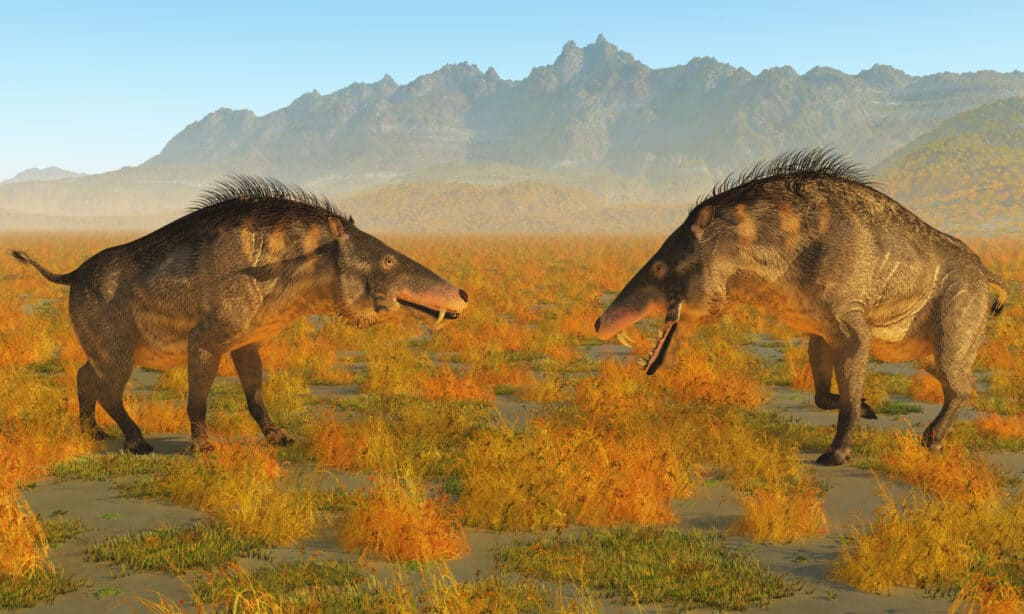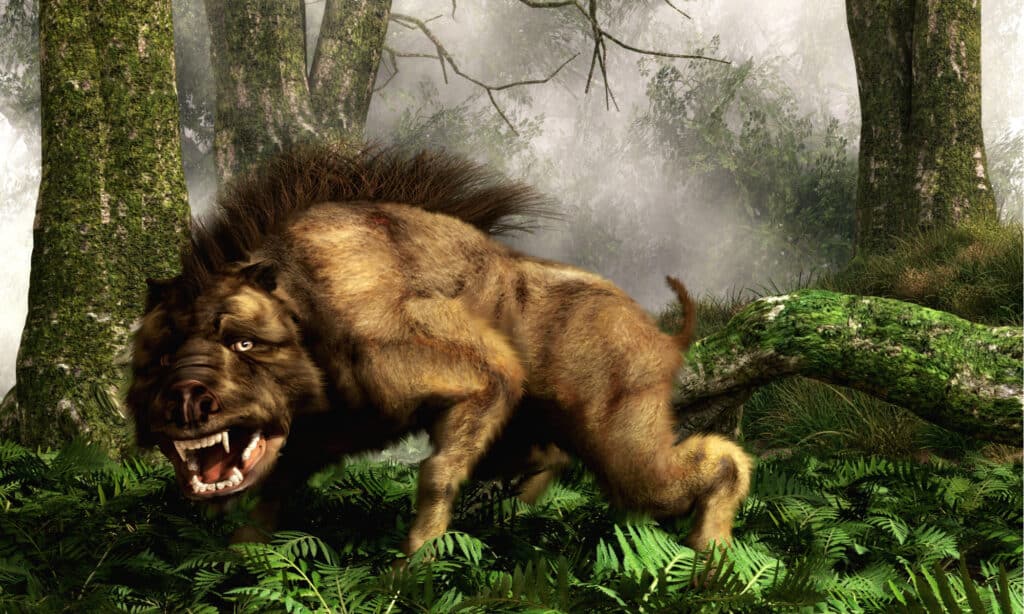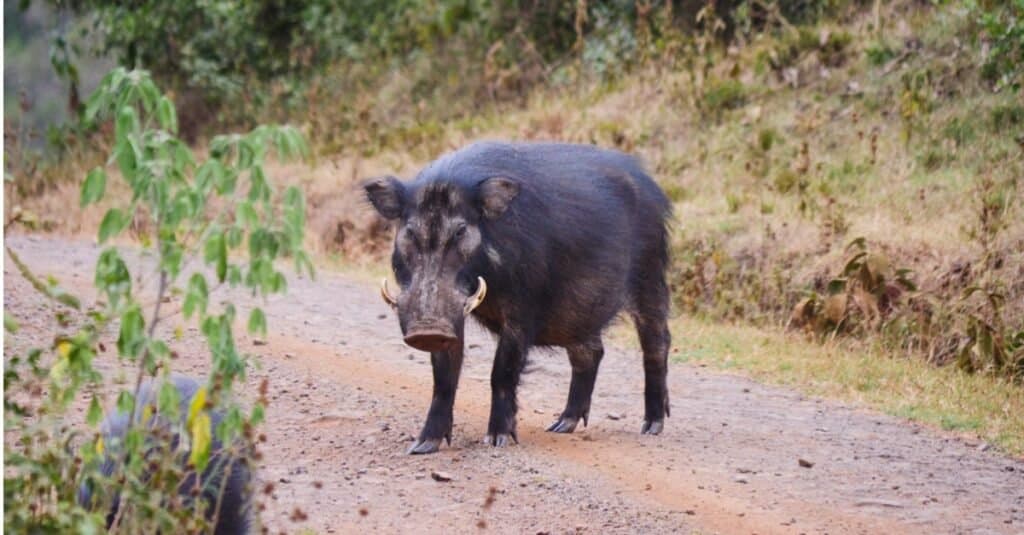Key Points:
- The Entelodont, the largest prehistoric pig to inhabit North America in the Eocene Period, could grow up to the size of a Clydesdale horse, with a weight up to 2000lbs.
- It’s difficult for researchers to classify the entelodont. Some studies mark it as an ancient predecessor of modern pigs, hogs, and boars, while newer studies suggest they may have been more closely related to hippos and whales.
- Scientists believe that the entelodont, a creature with cloven hooves instead of claws, would hunt prey by running alongside it before ramming into it with brute force.
Millions of years after the last dinosaur roamed the earth, a new generation of killer animals rose to power. The Eocene, between 56-34 million years ago, was ruled not by killer reptiles but by a new force of killer mammals. However, one colossal beast stood apart from the rest, ruling the North American continent with an iron hoof for 20 million years. Meet the Entelodont, the largest prehistoric “pig” that was taller than a horse and could take down animals as large as a rhinoceros.
What is an Entelodont?

Large Entelodonts could reach up to 10 feet in length and weigh up to 2,000 pounds.
©Daniel Eskridge/Shutterstock.com
Entelodonts are mammals that are part of the extinct scientific family, Entelodontidae. These pig-like animals were so formidable and ferocious that they earned the nicknames of “hell pigs,” “killer pigs” and “pigs from hell.” The first entelodonts appeared in Mongolia in the early to middle Eocene, around 50 million years ago. They spread across Asia and into Europe and North America where they ruled the floodplains and woodlands. Entelodonts were massive, intimidating creatures. Even the smallest type of entelodont was 330 pounds. The largest of these impressive pigs was at least the size of a Clydesdale horse, weighing in at 2,000 pounds.
What Did the Entelodont Look Like?
The entelodont was built like a tank with a very large body that stood upon surprisingly thin legs. These long, slender legs and its lightweight bones helped the enormous Entelodont to run at fast speeds. Its head was massive in comparison to the rest of its muscular form. However, it had a small brain around the size of an orange. The Archaeotherium, an entelodont in western North America, had a skull that was more than three feet long! Another entelodont, the Daeodon, was as big as a rhinoceros and had a skull that was at least 45% of its entire body length. To help carry and stabilize these oversized heads, entelodonts had packs of powerful muscles along the top of their spines down to their legs, and from the back of their heads down to their tails.
The face of the entelodont looked like a beastly pig or warthog, with a low, extended snout and extremely large teeth. Its cheek bones were especially unique, projecting outwards like two sides of a flamboyant bony mustache. These two massive cheekbones helped to leverage and supercharge the entelodont’s jaw muscles. Entelodonts could open their jaws up to 90 degrees wide. When they clamped down, they could crush bone with more force than a modern crocodile or hippopotamus.
Classification of the Entelodont

The Entelodont dug through the ground in search of roots and tubers like many modern pigs and wild boars do today.
©4028mdk09, CC BY-SA 3.0, via Wikimedia Commons – License
The entelodont is unlike any other animal on the earth today, making it difficult to classify. It was originally classified as a “true pig” because its appearance and anatomy resemble a giant pig. These pig-like beasts were classified as prehistoric artiodactyls (hoofed animals that bear equal weight on two toes). Over time, however, research has continued to show that the entelodont was very much its own animal. Today many scientists still see the entelodont as an ancient predecessor of modern pigs, hogs, and boars. However, new studies analyzing their genetics suggest that the “killer pigs” may actually have been more closely related to hippos and whales.
What Did the Entelodont Eat?
Paleontologists have discovered large grooves on their tusk-like canine teeth from digging for plant roots and tubers like many modern pigs. However, fossils from the Badlands of South Dakota clarified that the entelodont is an omnivore, eating both plants as well as meat. Several animal skeletons from this prehistoric watering hole had entelodont teeth marks in them, even large animals like rhinos. However, it is hard to know just how much of the entelodont’s diet consisted of plants, and how much of it was meat. Most likely, it would depend on what was available in the area at the time.
“Perfect Teeth” for Crushing Plants and Skulls
The mouth of the entelodont has confused and intrigued scientists for years. “Entelodon” is Greek for “perfect teeth” or complete teeth.” This name refers to their four different kinds of teeth. The canine teeth of the entelodont were so large that they stuck out of the mouth like massive tusks. They also had sharp incisors in the front of the mouth that angled forward slightly. The incisors carefully interlocked when the entelodont bit down, perfectly designed for grabbing and tearing flesh. However, they had large premolars and flat, solid back molars, perfect for grinding up any kind of plant matter. This suggests that the entelodont was an omnivore and ate both plants and animals.

Entelodonts had huge, muscular bodies and large, oversized heads.
©Catmando/Shutterstock.com
How Did the Entelodont Hunt?
The entelodont was large and strong enough to take down other animals, and had long, thin legs that allowed it to run fast. However, unlike other predators like bears and lions, the entelodont had cloven hooves instead of claws, so it could not grab its quarry. Recent research suggests that this formidable beast would instead run alongside its prey before ramming into it with brute force.
In Nebraska’s Toadstool Geological Park, scientists and paleontologists have been studying fossilized footprints preserved in the rock. Footprints from the entelodonts suggest that these animals may have let another predator do the killing for them, much like the modern grizzly bear. Grizzly bears often wait to for a wolf pack to take down an animal, and then scare the wolves off and take the carcass for themselves. Likewise, the entelodont tracks seem to progress in a zigzag pattern, suggesting that the killer pig would be smelling the air as it tracked a recent kill. Although their brains were rather small, they did have well developed olfactory nerves. This allowed them to sniff out and scavenge kills made by other predators.
Entelodont Evolution: Becoming the Terminator Pig

The Daeodon was the largest type of Entelodont and could bite through bones.
©Daniel Eskridge/Shutterstock.com
Around 25 million years ago the climate began to change. The planet grew colder, and vegetation became much scarcer. To survive, herbivores evolved larger bodies that could travel further distances in search of food. Predators, in turn, were forced to adapt as well—or die out in a mass extinction.
Entelodont fossils seem to disappear around this time. However, the entelodont didn’t die out completely—it simply evolved, becoming something much bigger and more menacing than ever before. This new, gargantuan type of entelodont, the Daeodon, is fondly referred to as the “Terminator Pig” by some paleontologists. The daeodon was the last entelodont to walk the earth. Its name, daeodon, is Greek, meaning “hostile” or “dreadful pig.”
This new “Terminator Pig” was four to five times bigger than the original entelodont. The daeodon measured over six and a half feet tall, larger than a modern bison. Its skull alone was over three feet long, allowing it to literally “terminate” anything that stood in its path with a quick headbutt or a single bite. The daeodon became the biggest and nastiest mammal to ever roam the North American Badlands.
Additionally, the daeodon had massive teeth and jaw strength. It could bite off bones and expose the substantial nutrients of the bone marrow. This was a prime source of nutrition for the terminator pig during mass extinction. Bone marrow can last inside long bones for several years after an animal dies, so even when there were few prey animals left, the daeodon had plenty of nutrients to survive on.
The Last Prehistoric “Pig”

Unfortunately, the daeodon was simply too large a beast to sustain without bigger prey to eat.
©iStock.com/chingkai huang
The daeodon not only survived the mass extinction, but it also thrived, dominating North America. However, within a few million years this enormous terminator pig would face a new challenge: the Bear-Dog. The bear-dog (amphicyonid) migrated to North America from Asia around 20 million years ago. This new predator was significantly smaller than the daeodon, but it had a few advantages over the terminator pig. The daeodon could only run fast for short distances, relying instead on its brute force. Bear-dogs, on the other hand, were long distance runners and could get to prey much quicker than the larger daeodon.
The bear-dog’s teeth also gave it a significant advantage over the daeodon. This new predator did not need to crunch bones or plants like the entelodont. Its teeth were much sharper and better suited to slashing and tearing flesh. Additionally, the bear-dog had a more advanced brain with an expanded neocortex. This new predator could think quicker and strategize better. It may have even hunted in packs to take down larger prey.
The evolution and adaptations of the daeodon, on the other hand, had focused on sheer size and power. As the bear-dog encroached upon the landscape, many larger prey animals, like the chalicothere (the terminator pig’s favorite food), disappeared. Unfortunately, the daeodon was simply too large a beast to sustain without bigger prey to eat. After dominating the food chain for 20 million years, the last entelodont on earth was gone.
An Exhibit to View and an Odd Statue Named “The Hyus”
One of the best fossil skeletons of a North American entelodont can be found at the Carnegie Museum of Natural History in Pittsburgh, Pennsylvania. In 1905, Carnegie Museum curator T.F. Olcott excavated the skeleton in the Agate Springs Fossil Quarry in Nebraska. A paleontologist from the same museum dubbed it Dinohyus hollandi, or “terrible pig.”
In 1909, a sculptor who made reproductions of prehistoric animals named Theodore Augustus Mills finished a model of what the Dinohyus hollandi would have looked like. Nicknamed “the Hyus,” this statue, which sat beside the bone display, had human-like eyes that seemed to gaze into the souls of its spectators at the museum. Eventually, it was relegated to the Big Bone Room in the museum’s basement.
Up Next…
- Prehistoric Pets Every wondered what kind of pets humans kept in prehistoric times? Read this article for some interesting facts.
- Dinosaur Size Comparison: Prehistoric Giants Check out a comparison in size of various giant prehistoric animals that once roamed our planet.
- What Were Cave Lions, The 12-Foot-Long Top Ice Age Predator? Imagine a giant prehistoric cave lion ready to pounce! Here’s some interesting details about this intimidating Ice Age predator.
The photo featured at the top of this post is © Daniel Eskridge/Shutterstock.com
Thank you for reading! Have some feedback for us? Contact the AZ Animals editorial team.






